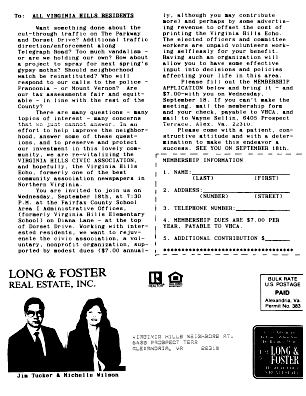By 1991, the Virginia Hills Citizens Association had been inactive for over five years. When Wayne Sellin returned to Virginia Hills from an overseas assignment for the Government, he found it a changed place. In particular, there had been a rash of petty crime and vandalism over the previous few years, and Sellin wanted to start a neighborhood watch. Upon contacting the Fairfax County Police Department, he found that there could be no neighborhood watch program without a citizens association to oversee it. He therefore determined to reactivate the Association.
Sellin began discussions with a number of his neighbors and former active members of the Association. Several preliminary meetings were held in the office of Jim Tucker, a local real estate agent. Early participants were Sellin, Tucker, Bob Gorman, Dick Wright, and David Billy.
Gorman, with the help of former Vice President of Administration Lester Kimbal, was able to locate the checks for the checking account (which had never been closed) and the Association seal. These had been given to the Baer family on Pike Road for safekeeping by former President Gary Schill when he moved out of Virginia Hills. Gorman was subsequently able to restart the checking account with the help of another Virginia Hills resident, Ruth Dove, the branch manager of the First Virginia Bank in Rose Hill.

It was agreed that an organizing meeting should be held on September 18, 1991 at the Old School. Jim Tucker devoted half of his real estate mailer to Virginia Hills residents to the meeting:
Want something done about the cut-through traffic on The Parkway and Dorset Drive? Additional traffic direction/enforcement along Telegraph Road? Too much vandalism - or are we holding our own? How about a project to spray for next spring's gypsy moths? Should the neighborhood watch be reinstituted? Who will respond to our calls to the police - Franconia - or Mount Vernon? Are our tax assessments fair and equitable - in line with the rest of the County?
There are many questions - many topics of interest - many concerns that we just cannot answer. In an effort to help improve the neighborhood, answer some of these questions, and to preserve and protect our investment in this lovely community, we are re-vitalizing the VIRGINIA HILLS CIVIC ASSOCIATION and hopefully, the Virginia Hills Echo, formerly one of the best community association newspapers in Northern Virginia.
The mailer went on to list the time an place for the meeting and included a membership form with dues set at $7.00.
At that meeting, temporary officers were elected to serve until the by-laws for the Association could be written and the Association re-incorporated. Wayne Sellin was elected president, Ed Zahrobsky vice president, Bob Gorman treasurer, June Thomas secretary, Dick Wright membership director, and David Billy, newsletter editor. Committees were formed to work on the "drive thru problem," on land use, and on re-lighting the Virginia Hills sign. By the close of the meeting, the Association had 55 members. The next meeting was scheduled for November 12th.
The first Echo of the new Association was published prior to the November meeting. At this meeting, the members approved the by-laws and voted to make the temporary officers permanent until July 1992. Bob Gorman was unable to continue as treasurer, and Jim Tucker was elected to the position in his stead.
The reactivation of the Virginia Hills Citizens Association in 1991 illustrates the stark contrast with the deactivation in 1985. First, the residents of Virginia Hills saw a distinct need for the Association's existence – as an organization to deal with the neighborhood problems of crime, cut-through traffic, and gypsy moths, and as an interface with (and check on) local government. Second, a number of volunteers stepped forward to serve as officers. It is clear that both these things are necessary for a citizens association to survive.
Sources: This article was written by Doug Boulter. Information was taken from Jim Tucker's September and October 1991 flyers, the minutes of the September 1991 meeting, the Echo for November 1991 and January 1992, and oral interviews with the original participants.